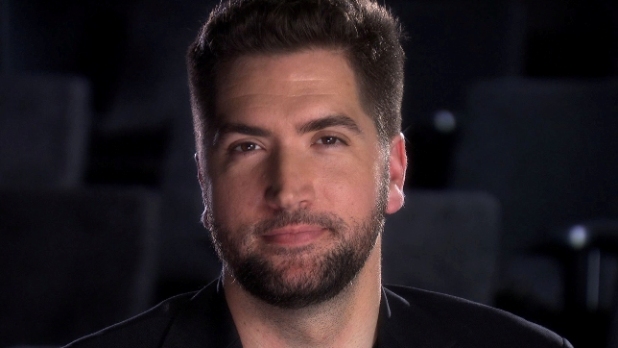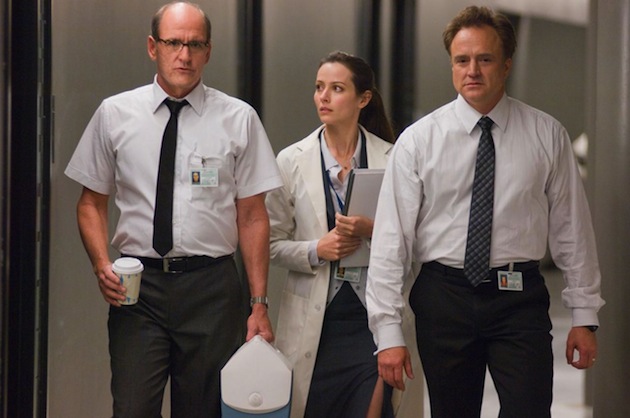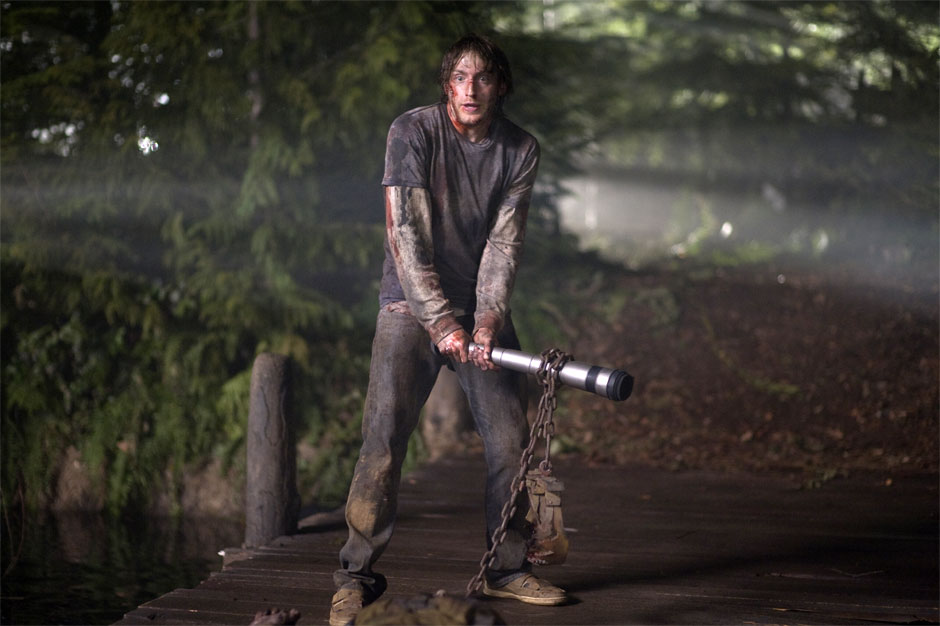 Back to selection
Back to selection
A Conversation with Cabin in the Woods Director Drew Goddard

They say you have to know the rules to break them. And Drew Goddard is a man very familiar with how to write for genre, collaborating over the last decade with some of the biggest names in American horror and sci-fi. In 2008 Goddard penned the screenplay to J.J. Abram’s found-footage monster movie Cloverfield, and before that he served as a series writer on television shows such as Buffy the Vampire Slayer, Lost, and Alias. So it should come as no surprise that his directorial debut, Cabin in the Woods, not only pays homage to the genre tropes implied in the film’s title, but expertly subverts them as well.
Too irreverent to call straight horror, and too acidic to call parody, Cabin is a hard film to define. But perhaps the biggest surprise that the movie has to offer is just how much subversion it manages from within the studio system. Playing like a friendlier, more irreverent version of Michael Haneke’s Funny Games, Cabin is a Trojan horse waiting to open on audiences this Friday
NOTE: The below interview contains mild spoilers. If you’ve seen the film’s trailer, there’s nothing here that you don’t already know. But consider yourself warned.

Filmmaker: Let’s start the beginning – how did you and co-writer Joss Whedon conceive of the premise for Cabin?
Goddard: It was originally Joss’ idea. We had been looking for something to write, because we missed each other from our days working together on Buffy and Angel. So we were just brainstorming ideas, and he said, “I’ve got this idea about a cabin.” And really as soon as he said, “Cabin,” I said, “Okay, yeah. I’m in.”
Filmmaker: Obviously you’re a fan of horror movies. What is it about the genre that draws you in?
Goddard: There’s something about facing the horrific – the things that scare you – that forces you to get in touch with the more unseemly sides of humanity. The stuff that’s true and there but we don’t like talking about at parties. It’s interesting to me. I feel like if you can study the horror film, you can probe who we are as a people more so than through other genres.
Filmmaker: How did that idea – to probe into who we are as a people – permeate through the script?
Goddard: I wish I could say there was a lot of intellectual thought during the scriptwriting process, but the truth is, we just started telling a story that we wanted to tell. And from there, the themes kept coming back. We kept finding ourselves questioning the genre, asking ourselves, “Well, why? Why do audiences want to see these horrific things?” Those sorts of questions kept coming up as we were writing, and very much informed the heart of the film.
Filmmaker: Let’s talk a bit about your career. How did you first get involved in writing?
 Goddard: I started as a production assistant. I came out to Los Angeles from New Mexico, and I didn’t know anybody. I just took the first job I could get – which was a PA on a TV show – and went from there. I worked on a lot of shows that got cancelled very quickly, but what was great about that was that every time a show got cancelled I would meet new people. So I just kept meeting people. And I was around writers. And then I started writing TV specs; because I had been working in that world so I sort of understood – okay, here’s how you do this.
Goddard: I started as a production assistant. I came out to Los Angeles from New Mexico, and I didn’t know anybody. I just took the first job I could get – which was a PA on a TV show – and went from there. I worked on a lot of shows that got cancelled very quickly, but what was great about that was that every time a show got cancelled I would meet new people. So I just kept meeting people. And I was around writers. And then I started writing TV specs; because I had been working in that world so I sort of understood – okay, here’s how you do this.
My dream was to write for Buffy the Vampire Slayer. I loved Buffy the Vampire Slayer more than I’ve ever loved a television show before or since. I just loved that show. And one of the writers I worked with was a friend of Marti Noxan’s over at Buffy. That person said to her, “You should read this script. I think Drew might fit be a good fit for what you guys are trying to do.”
And so they read it and they hired me that day. Marti called, and David Greenwalt (who was writing for Angel) called, and they both wanted me to come write on their respective shows. Joss was shooting Firefly at the time, so he didn’t even read it. They hired me without him even reading my spec, which was very nerve-wracking for me. But then Joss and I did our first episode together, which was a Buffy episode called “Selfless,” and it went very well. We just had a lot of fun together. You know – Joss and I just kind of hit it off on that staff. And we’ve been trying to work together ever since.
Filmmaker: Why do you think it is that you two are such a good match?
Goddard: I think that to some extent our voices are just similar. How we see the world, our aesthetic, what we find funny, and what we find sad – it just lines up. So you don’t have to force that. I think a huge part of writing is just taste and personal view. And we line up very well. I think part of it is, I just have such respect for him. From my point of view, there’s no better writer. It’s easy to work with people you really respect.
Filmmaker: What was the writing process like for Cabin? Did you and Joss literally write together?
Goddard: We worked on the outline together for months, just sort of batting it back and forth when we had time off from our day jobs. And once we got the outline to a place we were happy with, we locked ourselves in a hotel room. I had the upstairs and he had the downstairs, and we just wrote as fast as we could. We didn’t allow ourselves to leave that hotel until we were done.
Filmmaker: How long was that process?
Goddard: It was three or four days, something like that. But writing 8AM until 1AM. It was the most intense writing I’ve ever done. We knew we needed a ninety-page script, so that meant each of us had to do fifteen pages a day. It was hard. Certainly after those initial three days, we revised the script a lot. But it was nice to get the structure right initially, because Cabin is very much a structure dependent movie. The things that need to happen come from a skeleton. And once we locked all that into the script, things really started to come alive.
Filmmaker: Have you always wanted to direct?
Goddard: Yeah, absolutely. But it’s funny – Joss was pushing me to direct early, back on Buffy. And I just said, “Give me a chance to work on this. Let me prepare, let me get ready first.” Because I knew that directing was hard. You want to be on the top of your game. And I’m glad I waited until Cabin.
Filmmaker: What kind of steps did you take to prepare?
Goddard: To some extent, television just prepares you. Especially working for guys like Joss and JJ Abrams who are very writer specific and empower the writers on their shows to do a lot of different things. I was very comfortable talking to cast, and managing a day, and knowing what budgets you needed to worry about and what props needed to look like. That’s stuff you do on TV shows. And I have a lot of friends who are really great directors – I’ve lucked out in that sense. So I just sat down with them and talked about what to worry about, what not to worry about, how to handle everything, and the things they wished they had known when they first started. I find directors are all receptive. I’ve never met a director who didn’t want to be helpful to other directors. It’s nice.
Filmmaker: The two main sets in the film – the Cabin and the Lab – they’re so different. When you were first writing Cabin, how did you imagine the movie looking? Were there specific visual cues that you had in mind?
 Goddard: I knew that the movie was going to go to such absurd places at times, and so I decided that I really wanted to balance that through the visuals. I wanted the film to feel elegant and controlled. Part of that was a reaction to what I’d seen a lot in current cinema. I didn’t want “shaky crazy camera” work. I think that can delude tone. And I don’t mean to trash that style, because I do think it has its place, and I might want to do it again in another movie. But this movie, because the narrative gets so crazy, I wanted to counterbalance that through the visuals. That was one of my goals when I sat down with our cinematographer, Peter Deming. That’s actually one of the reasons why I hired him. If you look at some of the other films he’s shot – like Mulholland Drive – the assuredness of that movie is right in the wheelhouse of what I was looking for.
Goddard: I knew that the movie was going to go to such absurd places at times, and so I decided that I really wanted to balance that through the visuals. I wanted the film to feel elegant and controlled. Part of that was a reaction to what I’d seen a lot in current cinema. I didn’t want “shaky crazy camera” work. I think that can delude tone. And I don’t mean to trash that style, because I do think it has its place, and I might want to do it again in another movie. But this movie, because the narrative gets so crazy, I wanted to counterbalance that through the visuals. That was one of my goals when I sat down with our cinematographer, Peter Deming. That’s actually one of the reasons why I hired him. If you look at some of the other films he’s shot – like Mulholland Drive – the assuredness of that movie is right in the wheelhouse of what I was looking for.
In terms of design, the downstairs – the Lab – is very much influenced by my hometown. I grew up in Los Alamos New Mexico, which is where they built the Atomic Bomb. And the whole town is just this nuclear research lab, and that’s all it is. That’s pretty much the reason the town exists. So you have this suburban group of people, and all anyone does for a living is make weapons for the government. I wanted to capture that vibe. Those were my friends and my family growing up, who went go out and did that job that was very hard to do.
Filmmaker: Do you have an all-time favorite horror movie?
Goddard: I think my favorite horror movie is The Thing. I just love Carpenter so much in general. I think it’s beautiful – the elegance with the way it’s shot, and the human drama of it all. It’s one those movies where you could take the horror part out of it and it would still be captivating. I also think it has the best ending of possibly any movie ever made.
Filmmaker: So far we’ve been talking about Cabin as strictly a horror movie, but it’s also got some very strong comedic elements. Was it difficult to balance those two genres?
Goddard: It was the hardest part of the job – maintaining that tone. Because we do both, we go from horror to comedy and comedy to horror. And you have to be really careful with that, because with comedy it would have been very easy to veer too far into parody. And if you go the other way, suddenly you’re becoming that which you’re commenting on. And so we really had to walk the line.
In terms of balancing the tone, I found what it usually came down to was my gut reaction. There’s no way to completely intellectualize it. I just had to think about each scene and say, “Okay, we’ve gone too far here, let’s dial it back,” or, ‘this is a good place where we could take things a little further.” You just have to trust your gut as you go.
Filmmaker: You’ve got a great ensemble, but I think Fran Kranz really stands out. How did you work with him to take that very archetypical stoner character that he plays and make him into something deeper?
 Goddard: All five of our kids had to play two roles – the character and the archetype. And Fran’s interesting because he had to start out as the archetype, and then become the character. Everyone else starts out as real, fully-formed characters and then become archetypes. I definitely talked about that a lot of Franz. And he understood what we were trying to do. So from there it was just about letting his instincts take over, because he really has strong instincts. He really got what we were up to. We just let him do his thing.
Goddard: All five of our kids had to play two roles – the character and the archetype. And Fran’s interesting because he had to start out as the archetype, and then become the character. Everyone else starts out as real, fully-formed characters and then become archetypes. I definitely talked about that a lot of Franz. And he understood what we were trying to do. So from there it was just about letting his instincts take over, because he really has strong instincts. He really got what we were up to. We just let him do his thing.
Filmmaker: The marketing campaign is very much built around keeping a lot of the movie a secret. Why did you guys decide on that strategy?
Goddard: I don’t think audiences want to know everything before they go into a theater. I think some people want to be spoiled, but the trick is to protect the audience members who want to be protected. Most people want to know enough to know that the movie’s going to be worth their time. But after that – that’s why they’re going to the movies – to experience surprise, and discover things. You can only get that communal aspect of discovery from going to a movie. So we wanted to protect that. It’s that balancing act of saying, ‘this is worth your time but we’ve got a lot more to show you. Stuff that’s worth paying for.” (laughs)
Filmmaker: In a way, Cabin feels like a very timeless movie. It plays like something vying to be entered into the cult cannon. How do you view the film’s place in the wider history of the horror movie?
Goddard: I didn’t want Cabin to be a movie about right now. I wanted it to be a movie about the genre; about the timelessness of the horror genre. And so I took care to make it about a lot more than just what’s happening in horror cinema today. I didn’t want to comment on specific things – on things that would just be the flavor of the month. I took active pains to avoid that, because what I wanted to say was that this isn’t just about what’s happening right now, This is about the genre as a whole – and movies as a whole. And who we are as a people. That’s why I actively fought against including pop culture references and current tropes. I wanted to keep it timeless.
Filmmaker: As much as Cabin is a love letter and homage to the horror film, there’s also an implicit critique of the genre going on here. Are there aspects of horror films that you wanted Cabin to address and critique?
Goddard: It’s more a critique of society. The question that is interesting to me is – why do we feel this need to marginalize youth on screen?” Why do we feel this need to idealize youth, and then slaughter them? What is it about that that is so satisfying to us as viewers? And it’s not just in movies, it happens in society. As I get older I notice it more. We take youth, and we build it up to be this great thing. We package it and say, “Everyone in society fits into one these boxes.” And then we destroy it. We rip it down.
That’s been happening forever, you know? We talk about that in Cabin, that this is not new. There’s a timeless quality to our destruction of youth that’s very interesting to me. I feel Cabin is much more a critique of that – of those things that the horror movie suggests are deep within us as a people. To me, that’s fascinating.
